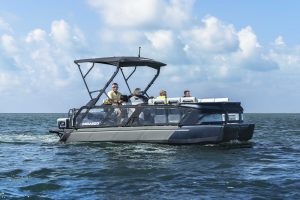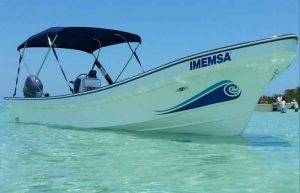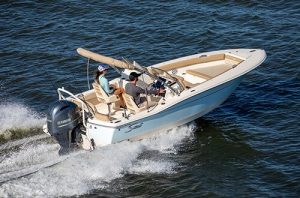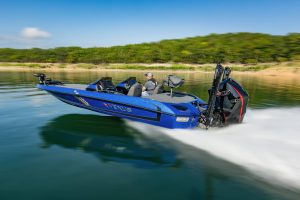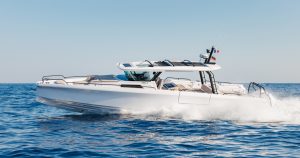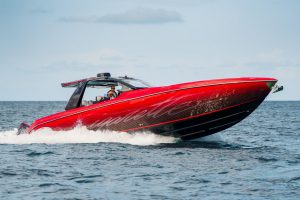Freshwater Fishing Boats: A Comprehensive Guide for Anglers
Freshwater fishing boats are designed to cater to the unique needs of anglers who enjoy fishing in lakes, rivers, and streams. These boats come in a wide range of sizes and styles, ensuring that there is a perfect option for every type of freshwater enthusiast. From small, one-man vessels to larger, power-packed models, the options are seemingly endless when it comes to selecting a boat that best matches one's preferences and budget.
Many freshwater fishing boats offer features specifically tailored for the angler's needs, such as specialized storage, live wells, and adaptable seating. In addition, these boats are often outfitted with advanced technology to help locate fish more efficiently and navigate bodies of water with ease1. With so many choices available, it is essential for potential buyers to research and consider their personal fishing style and preferences when searching for the ideal freshwater fishing boat.
Some popular models of freshwater fishing boats include the Crestliner 1660 Retriever, Lowe SF 212, Lund 189 Pro-V GL, and Ranger Z Comanche 521L, among others2. Each of these boats offers its own unique advantages and features, making the selection process a truly individualized experience for the discerning angler.
Types of Freshwater Fishing Boats
Freshwater fishing boats come in a variety of designs to cater to the needs of different anglers. In this section, we will discuss some popular types of freshwater fishing boats, such as bass boats, flats boats, and bay boats.
Bass Boats
Bass boats are a specialized type of freshwater fishing boat, specifically designed for targeting bass. These boats typically feature a sleek, low-profile design and a powerful engine, which allows for high-speed navigation of bass-rich waters. They also have ample storage for fishing gear, a trolling motor, and casting platforms on the bow and stern for efficient angling.
One characteristic of bass boats is their shallow draft, which enables them to access shallow, weed-infested waters where bass often hide. Additionally, bass boats usually have advanced electronics to help locate fish, such as fish finders, GPS systems, and modern sonar technology.
Flats Boats
Flats boats, also known as skiffs, are designed for fishing in shallow water areas. They are characterized by their flat-bottomed hull, which allows them to navigate shallow flats and mangroves while minimizing the risk of grounding. This makes them ideal for anglers targeting species like redfish, bonefish, and tarpon in shallow, coastal environments.
Flats boats typically have a simple layout, usually equipped with an elevated poling platform at the rear of the boat, which allows the angler or a guide to pole the boat silently through the shallows in search of fish. They usually have minimal accessories and built-in storage to reduce the boat's overall weight, allowing it to glide smoothly over shallow waters.
Bay Boats
Bay boats are versatile freshwater fishing boats that can navigate not only shallow bays and estuaries but also deeper offshore waters. They have a V-shaped hull, which performs well in choppy conditions and provides a smoother ride in rough water compared to flats boats.
These boats typically come with higher gunwales, a center console design, and ample storage for fishing equipment. They offer a good combination of stability, maneuverability, and capacity, making them suitable for both freshwater and light saltwater applications. Some common fish species targeted by bay boat anglers include speckled trout, snook, and flounder.
Key Features
Hull Design
Freshwater fishing boats come in various hull designs, each offering different benefits and performance. One of the most common hulls found in freshwater fishing boats is the V-shaped hull, providing excellent stability and handling in various water conditions. Another popular hull design is the flat-bottom hull, which offers excellent stability in shallow waters, making it ideal for fishing in lakes and rivers.
Seating and Storage
Comfortable seating arrangements and ample storage capacity are critical features for any freshwater fishing boat. Most fishing boats offer swivel seats and benches, allowing anglers to fish comfortably and maintain better access to their equipment. In addition to seating, there should be sufficient storage for fishing gear, tackle, and personal belongings. Some fishing boats also offer integrated tackle organizers, lockable ventilated rod storage, and live wells for keeping the catch fresh.
Electronics and Navigation
Modern freshwater fishing boats are equipped with advanced electronics and navigation systems to assist anglers during their trips. Some common features include GPS devices, fish finders, trolling motors, and marine radios. A quality freshwater fishing boat should have a reliable GPS system for navigating and marking fishing spots. Fish finders can help anglers locate fish, while trolling motors enable slow, precise navigation for better casting opportunities.
Advanced freshwater fishing boats may also include more sophisticated electronic and navigation features, such as Minn Kota Terrova trolling motors with iPilot link and Bluetooth, or Humminbird Helix fish finder devices. These features can significantly enhance the fishing experience, providing anglers with valuable data and increased control over their boat's positioning and speed.
Propulsion Options
Freshwater fishing boats come equipped with various propulsion systems to suit different needs and preferences. In this section, we'll discuss two popular types of motors: outboard and inboard motors.
Outboard Motors
Outboard motors are the most popular choice for freshwater fishing boats due to their versatility and ease of maintenance (BoatUS). These engines are located on the outside of the hull, either at the transom or the bow, and can be easily raised or lowered depending on the water depth or when not in use. Some advantages of outboard motors include:
- Easier access for maintenance
- Ability to change the trim angle to optimize boat performance
- Lighter weight compared to inboard engines
- Power range from small trolling motors to large, high-horsepower engines
Many freshwater fishing boats utilize small trolling motors mounted on the bow for maneuvering while fishing (boats.com).
Inboard Motors
Inboard motors are less common on freshwater fishing boats due to their design and layout. These engines are located within the hull and generally have a straight-shaft configuration (BoatUS). Inboard motors have some advantages and disadvantages compared to outboard motors:
| Advantages | Disadvantages |
|---|---|
| Lower center of gravity, providing improved stability | Increased weight |
| Less engine noise in the cockpit | More complex and costly maintenance and repairs |
| Mechanical simplicity and reliability | Less versatile when navigating shallow waters |
When choosing a propulsion system for your freshwater fishing boat, consider your specific needs, preferences, and the type of waters you plan to navigate.
Choosing the Right Boat
When looking for a freshwater fishing boat, considering factors like the type of fishing you will be doing and your budget constraints are crucial. In this section, we will discuss the key elements to guide you in making an informed decision on the suitable boat for your freshwater fishing adventures.
Types of Fishing
One of the initial things to contemplate when choosing the right boat is the type of fishing you plan to do. Several freshwater fishing boats cater to various angling preferences:
- Bass Boats - Specifically designed for catching bass and other panfish, these boats often come with swivel chairs for casting from any angle and storage for bait, rods, and lures.
- Aluminum Fishing Boats - Lightweight and easy to transport, these boats offer versatility and durability for different fishing styles.
- Multi-species Boats - Designed specifically for versatility in chasing various species in different water bodies.
Evaluating your angling preferences and the targeted fish species will lead you to choosing the optimal boat type that meets your requirements.
Budget Constraints
Investing in a fishing boat could range from affordable to a more luxurious arrangement. Understanding your budget constraints and researching options within that framework are important aspects to consider.
You may choose an Aluminum Fishing Boat if cost-effectiveness is your priority. On the other hand, if you can spend more for additional features and comfort, a top-of-the-line Ranger Z Comanche 521L or Campion Rage R22 may be worth considering.
Keep in mind that there are various financing options available, and many dealers offer discounts or incentives during boat shows and promotional events. Weighing your long-term needs and the available options within your budget will ultimately help you select the right fishing boat.
Maintenance and Care
Freshwater fishing boats require regular maintenance and care to ensure their longevity and optimal performance. By following a routine maintenance schedule, owners can avoid issues that may arise from neglect and prevent costly repairs.
It is essential to clean the exterior of the boat using a boat cleaner designed specifically for boats as these are gentler on the boat's surfaces and more environmentally friendly. Using a soft, large sponge to wash the hull in gentle, circular strokes helps prevent damage to the paint and gel coat.
For the engine, decarbonizing the fuel system regularly can help reduce carbon buildup and improve overall engine performance. It is recommended to perform this maintenance every 20 to 24 hours during the active boating season.
It is also important to store fishing gear and tackle properly when not in use, especially during the offseason. As suggested by boats.com, removing these items from the boat and storing them indoors can help extend their lifespan.
Battery care is another crucial aspect of boat maintenance. If possible, remove batteries from the boat during the offseason and store them at home on a trickle charger to keep them topped off. Additionally, checking electrolyte levels in lead-acid batteries is recommended.
Lastly, for boats used in saltwater, extra attention is required due to the corrosive nature of salt. Rinsing off boats and trailers with a garden hose after each use can help prevent saltwater damage. However, avoid using a high-pressure washer as it may cause harm to the boat's surfaces.
Conclusion
Freshwater fishing boats offer a diverse range of options to cater to the needs of anglers. From simple Jon boats to high-performance bass boats, each type has its unique features and advantages. Choosing the right boat largely depends on personal preferences, fishing style, and location.
Technology advancements have contributed to the increasing popularity and versatility of freshwater fishing boats. Modern boats are equipped with a variety of amenities that help anglers fish efficiently, while some boats are designed specifically for use in sweetwater environments.
Some popular freshwater fishing boats include bass boats, bay and flats boats, and center consoles. These boats not only provide excellent performance in freshwater, but they're also adaptable for occasional use in coastal waters for saltwater fishing.
Overall, selecting the best freshwater fishing boat comes down to understanding your individual needs and prioritizing features that align with your fishing style. With the wide range of options available on the market, finding the perfect boat may seem challenging, but by considering factors such as size, features, and price, anglers can make an informed decision that enhances their fishing experience.
